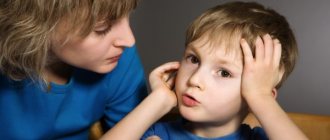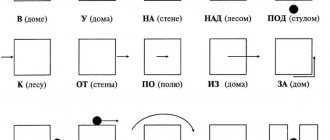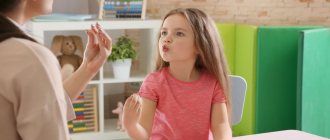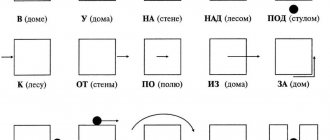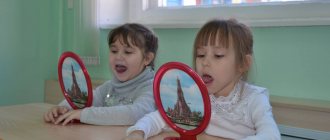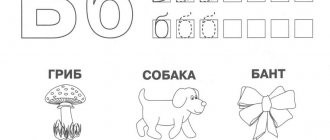Games for the development of phonemic awareness. Sound S, S.
Game "Clapping". Game option 1.
Ask your child to clap if he hears the S sound in a word.
Mix words with the C sound in different positions (at the beginning, in the middle or at the end of words). For example: telephone, boots, dad, fruit drink, book, rain, nightingale.
The child claps when he hears a word with the sound C (do not confuse the sounds themselves with and Сь - these are different sounds, although the letter is the same!)
If it is difficult for a child to hear the sounds in a word, then say the words in a drawn-out manner, for example mmmoooooorrrsss. This game teaches the child to distinguish different sounds in speech and develops phonemic hearing.
Option to complicate the game:
You can give the task to clap if you hear the sound C and stomp if you hear the sound C.
Game "Clapping". Game option 2.
Tell your child, “Clap when you hear the syllable Sa.” Next we say a sequence of syllables, for example: sa, na, sha, sa, for, ra, yes, sa, tsa, sa, la, cha. Does the child distinguish between the sound C and the syllable SA in the speech stream? Is it confused with other similar sounds? Children very often confuse the syllable sa with the syllables za or tsa, as well as with hissing syllables with the syllable sha. And it is very important for us to teach children to distinguish between these sounds and syllables. This is also important for teaching writing at school, so that the child does not confuse these sounds and the letters that represent them in written speech when he begins to write.
Game "Echo"
Repeat three syllables in a row, and the child should repeat them as an echo, that is, a little quieter than you say. If your child repeats three syllables easily, increase the number of syllables in the repetition chain. Be sure to praise and encourage the little “echo.” If the “echo” makes a mistake, repeat the chain of syllables again.
Examples of tasks:
- sa-so-sy
- as-us-is-as
- Sam-garden-sav,
- so-su-si-su
- asa-aso-asu-asy, etc.
Game "Guess what whistles?"
You will need two pictures - “pump” and “water flowing from the tap”. You can draw them yourself (schematically depicting the pump and tap). The main thing is that they are recognizable to the child.
Show your child a picture of a pump. Say: “The air coming out of the pump whistles like this: ssssssssssss. He whistles angrily sss!”
Show the second picture and say: “Water is pouring from the tap. The water whistles softly, sit like this.”
Ask the child to say how the water whistles (ss-s-s-s) and show the corresponding picture. Then ask him to imagine how the air whistles from the pump - sssss - and show the desired picture.
Next, say: “Now we are going to play an attentiveness game. If you hear the pump song - a solid sss sound - then pick up the picture of the pump. And if you hear the song of water - a soft sound - then pick up a picture of water.” You say these sounds separately (s-s-s-s-s-s-s-s), and the child picks up the desired picture. First the game is played with sounds, then with words. You say a list of different words in random order: door, nightingale, herring, frost, banana, hat, water, and so on. If the word contains “pump song - hard sound C,” then the child raises up the picture with the pump. And if the word contains the sound s - a soft sound, “song of water”, then you need to raise the picture with water. If there is neither one nor the second sound, then there is no need to raise the pictures.
Prank game with sound C "Confusion"
Children are asked to guess which words are mixed up and put them in their places.
Examples of confusion-jokes with the sound C (Author L. M. Kozyreva, from the book “Speech Development. Children 5-7 years old”):
- A carp lives in the forest. A pheasant swims in the river. (Correct - “A pheasant lives in the forest. A carp swims in the river”).
- They gave us a delicious robe for lunch. Alyonushka has a new salad.
- A polar cod was flying in the clouds. There was a seagull on the table.
- The pike perch has two pike perches (correctly – “the pike perch has two pike perches”)
A few more confusions of the famous author of poems for children A. Shibaev:
- In front of the children, painters paint a rat. (Not a rat, but a roof. Instead of the sound S, you need to put the sound Ш).
- They say that a fisherman caught a shoe in the river. But then he got hooked on the house. (Not a house, but a catfish)
- The lazy guy is lying on a cot, crunching and gnawing on his guns. (Not guns, but dryers)
- The lion drops his leaves onto the yellowed grass. (Not a lion, but a forest)
A few of my own jokes - confusions for activities with children:
- That's it, daughter! Beauty! My daughter has a long goat! (not a goat, but a scythe).
- At Anya’s house, the bowl lives, dances, plays and sings songs! (Not a bowl, but a bear. Another correct option for replacement is a pussy).
- Katya ate a tasty tooth. Katya's soup is sick. (On the contrary, I ate soup and got a toothache).
- There is an owl in the room. And there is a sofa sitting in the forest. (No. There is a sofa in the room, and an owl in the forest).
Children usually laugh when they hear a joke - confusion. But not every child can correct a mistake and unravel the confusion. If a child has speech impairments, then you often have to give a hint - “Which word is lost? Which word fits the meaning? The answer also begins with the sound m. This is a toy. Guess what this is?)
Game “Find the “s” in the names of objects”
A similar goal is pursued by the teacher during the next game. It is necessary to prepare cards with several pictures to work on automating the sound “s” in words. The consonant being studied should be in different places: in the middle, at the beginning and at the end of the word.
During this game, the baby not only trains to clearly pronounce words with sounds that are difficult for him, but also learns to determine its place in a word. This will help in preparing the child for school and in learning to read and write. The speech therapist’s task is also fulfilled, because his ward clearly and correctly pronounces words where “s” is present in both forward and backward syllables.
"Collect the letter"
You can make such a simple puzzle yourself while working on the automation of any consonant. You need to cut out a large letter from a sheet of cardboard, cut it into separate elements and on each of them glue a picture with this consonant at the beginning of the word. In our case, this is the letter “c”. You can choose subject pictures as in our photo, or come up with your own.
In addition to developing the articulatory apparatus and pronouncing the sound being studied, children develop logical thinking and attentiveness, because they need to analyze the shape of the piece and find its place in the whole image of the letter, aligning the edges correctly.
Game "Count the objects"
To automate the “s” at the beginning of a word, you can offer children an interesting and educational game. The card shows objects whose names begin with the learned syllables:
- Su - bag.
- Su - chest.
- So - juice.
- Sa - sandals.
- So - catfish.
- So - sable.
The child points to an object with a pointer or finger and names it, then looks for the same one further down the row, and when he finds it, again says its name out loud. Thus, as the game progresses, the child several times calls the word the teacher needs, which begins with the learned syllable. This game develops not only speech, but also attention. The child learns to find the same ones from a large number of pictures, without missing a single one.
Pure talk
After this stage, automation of “s” in words is not yet carried out. Work is underway to combine it into syllables.
According to the method, fricative consonants such as “s” are first learned in simple syllables, for example, “so”, “se”, etc. Then the work is carried out with reverse syllables, when the vowel comes first, followed by the consonant , for example, “as”, “us”.
Pure sayings are widely used in pedagogy, when children pronounce separate syllables after the teacher, and then sentences with this syllable at the end.
At first, the child simply repeats all this after the speech therapist. Next, you can offer several exercises to develop phonemic awareness and attentiveness, since children often do not hear and do not understand which sound needs to be inserted into a word. Let's list some of them:
- “Continue the word.” The teacher says the beginning of the word, and the child finishes its last syllable. To make the task easier, you can offer your child subject or story pictures. The following words will do:
-fox;
-sausage;
-bu – sy;
-hair;
-watch.
- “Switch places.” The adult offers to determine the place of “s” in the syllable: at the beginning or at the end. When the child has correctly indicated its location, the teacher asks to swap the vowel and consonant, for example, it was “sa”, but needs to be converted to “as”. It is advisable to carry out such an exercise to develop the skills of phonemic analysis and synthesis.
Stage II of work
(conducted as part of the lesson)
Subject . Clarifying the pronunciation of an existing sound s' or evoking it by imitation. Development of phonemic hearing. Target . Achieve the ability to correctly pronounce the sound s' and distinguish between the sounds s and s' by ear.
Previous work . Children were taught to correctly pronounce the sound s and distinguish the sounds f - v, t - d.
Preparatory work . Prepare pictures for the number of children depicting a thin stream of air coming out of the pump and a thin stream of water pouring from the tap (the number of both pictures should be 2 more than the number of children).
Game "Guess what whistles"
Brief description The teacher or speech therapist shows a picture of a pump and asks the children to say how the air whistles when it comes out of the pump. (“Sss...”) “That’s right, the air coming out of the pump whistles “angrily”: “ss...” How does it whistle? (“Angrily”: ss.”)
Now listen to how a thin stream of water whistles when it flows from the tap (shows a picture). She whistles tenderly, softly: “Hush…” Let’s all whistle together, like a thin stream of water...
Now take the pictures from the table. Pick up the picture showing the pump. How does the air whistle when it comes out of the pump? (“Ss.”) Lower it. Pick up a picture of a trickle of water flowing from a faucet. How does a trickle of water whistle? (“Hit.”)
Now I'll check which of you is attentive. If I speak angrily, you will bring up a picture of a pump. If I say gently, softly, “suck,” you will pick up a picture of a trickle of water.”
(First, you can call two children who are good at distinguishing these sounds by ear, then play the game with all the children or in subgroups.) Methodological instructions. When the teacher pronounces the sound s', he needs to smile more, that is, pull back the corners of his mouth, then the sound will be softer.
Automation of "s" - "sh" in words
In speech therapy, the differentiation of similar-sounding “s” and “sh” is often used. The work is carried out according to the same plan as for one sound:
- Pronouncing an isolated “s”, in our case a pair.
- Training in the pronunciation of forward syllables, then reverse ones, in combination with an additional vowel or consonant.
- Pronouncing words, and then sentences, whole phrases. The sounds selected for work must be in the same sentence. The game “What’s on the hat?” will help you with your work.
The child must look at the picture and make a sentence like: “There is a leaf on the hat.”
Games for automating the sound S and S in words
Game “Tails” (author of the idea - S.A. Maksakov)
Show your child a strip of paper and tell him that different words are hidden in it - encrypted. The words are all different, but they have the same beginning. We need to figure out what words these are.
An example of a task: hidden in a strip are words that begin with “ska.” What words are these? Tell your baby: “I’ll start, and you continue: ska-... (make-up), ska... (rolling), Ska... (zka), ska... (rub).” If it is difficult for your child to guess, draw a small picture in which you depict part of an object and ask him to guess what kind of object it is and what kind of word it is that starts with “ska”.
Another example for this game is words starting with “sa”: sa... (fly), sama, sleigh, scooter, Saratov, Sasha, Sanya, independent, Samarkand, lard, bag, samovar, boot, Savka, garden, garden , gardener, soot, carp, fireworks, net, saber, sausage, sardines.
If you find it difficult to find words for a certain syllable, then there is a good helper - a dictionary. Introduce your child to a Russian dictionary, show him how to find words in it, read to him about several new words starting with the desired syllable.
Game "Assemble a basket"
I usually play Tails and other game variations a little differently. It is very important for preschool children to see clearly the results of their actions. But in speech there is usually no such visual result that can be seen or touched. This is why children love to draw, sculpt, and do various crafts, but do not really like speech exercises. Let's take this feature of young children into account. I came up with a special game technique for teaching speech and called it in my research “visual result of children’s speech.” Despite the complex name of the technique, it is very simple and interesting, and all children like it, getting them interested in completing the speech task. The essence of this technique is for the baby to see that his speech action leads to a visual, tangible and vital result.
Tell the children that the Old Man-Speech lost all the words from his basket and was very upset. How can I help him? The words are lost - scattered all over the world (or throughout the album) and need to be collected again into one basket. The basket contained words with the sound S. We need to find them among other words. This is a game situation in which we will use visual speech assessment. Let's see how in a situation with a basket we can organize a visual assessment of children's speech actions.
We draw a silhouette of a basket on a board or easel, which we will “fill” with words. The task is to fill the basket completely. This is how you fill the basket: As soon as you and your child come up with a word, draw this word in the silhouette of a basket (for example, it will be an oval) and paint it over (color the oval). It's as if we "put" the word in a "basket". Next, each word with the sound C adds another oval to the basket. The game ends when we have completely “filled the basket with words.”
You can take a real basket and fill it with “words” - cubes from a building set.
In this game you can give any tasks - put words with the sound S in one basket, and words with the sound S in the other. Or collect in a basket only words in which the sound C is in the middle of the word. Or only words starting with the syllable Sa.
Children usually remember well where the word each child came up with is in the basket, what color it is, and point with their finger: “I put this in.” And this is Svetino’s word.” If you play in pairs with a child, then he remembers well where your word is, and where his words are and “who put in more words” :).
Automation of the sound [c] in a direct syllable.
Pronounce (read) syllables. sa-so-su-sy sy-cy-co-sa; so-su-sa-sy sa-sy-so-su; su-sa-sy-so so-su-sa-sy.
Pronounce (read) words.
With emphasis on the syllable: garden, sam, lard, sleigh, cod, sugar, wasp, scythe, fox, dew, gander, annoyance, write, bite, mustachioed, landing, beauty, stripe, sausage; juice, catfish, sleep, litter, variety, Sonya, soda, falcon, hill, hundred, barefoot, piece, forest, sock, sand, belt, sedge, tall, wheel, beans, brine; court, bitch, soup, dry, vessel, bag, carrying, shepherding, dishes, drawing, carrying, dancer; son, cheese, full, sprinkle, mustache, scales, noses, barefoot, scarf, sprinkle.
Without stress on the syllable: gardens, garden, salad, salute, sapper, boot, satin, cash register, mass, samovar, plane, orderly, sundress, napkin, Larisa, wheels; cloth, be able to, snowdrift, chest, harsh, souvenir, rice, fruit drink, take out; raw, cheesecakes, son, full, wasps, beads, braids, blond, hair, stripes, rails, write out, send.
Pronounce syllables with a combination of consonants: sva-svo-svu-svy; ska-sko-sku-sky; sl-slo-slu-sly; sma-smo-smo-smy; sleep-sleep-snu-dreams; spa-spo-spo-spa; hundred-hundred-stu-sty.
Pronounce words with a combination of consonants: pile, dump, cook, your own, appropriate, firmament; rock, rolling pin, jump, tablecloth, bench, how many, soon, frying pans; glory, weak, sweet, word, elephant, like, rumor, chance; smog, look, tar, dark, wash away, shell, sheaf, again, dreams; sleep, Spartak, oversleep, dispute, argue, satellite, confuse; flock, steel, shutters, put, glass, old man, pier, put, get; one hundred, table, so much, stand, wait, tincture; knock, chair, cold, mortar, steps, get cold.
Speech therapy game “Help the baby elephant”
Let's look at another educational game for automating the sound “s” in words. In it, three buckets are first placed in front of the baby elephant. Each one has an object drawn on it. It must begin with a given consonant, or end, or have the sound being studied in the middle of the word.
For example:
- (Traffic light.
- Dog).
- Armchair.
The set includes a whole set of subject pictures depicted on the buckets. The child needs to distribute the cards into cells. You can make such a game not drawn on cardboard, but three-dimensional. Prepare three empty plastic buckets and a soft toy, such as an elephant or a bunny. On each of the buckets, stick a sample with a picture of the item. The child takes out pictures from the set one by one, names the object and determines the location of the “s” in its name.
You can separately do a task to automate “s” in the middle of a word, at the end or at the beginning. This game promotes the development of phonemic awareness, the ability to find “s” in words, and correctly determine their location.
